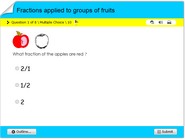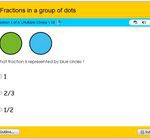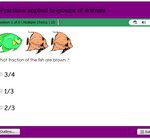Fractions applied to groups of fruits quiz
Math Fractions quiz applied to groups of fruits exercise.
Math quiz on finding fractions that represent a given number of fruits
Math quiz on finding fractions that represent a given number of fruits. This is a free math activity for children in 1st, 2nd and 3rd grades to review their fraction skills. This quiz depending on how you look at it could be considered a math test or a math game online. It is a great way to learn because children get instant feedback as they play along. This quiz is an interactive math activity which uses pictures and visual aids to enable kids catch the notions easily. Have free fun online and please help us to spread the word.
Finding fractions that represent a given number of fruits can be a useful skill to have, whether you’re trying to divide a batch of cookies evenly among your friends or trying to come up with the right amount of fruit to include in a recipe. In this math quiz, we’ll look at some different methods for finding fractions that represent a given number of fruits and practice applying them to a variety of different problems.
One way to represent a given number of fruits using fractions is to use unit fractions. A unit fraction is a fraction whose numerator (the top number) is 1 and whose denominator (the bottom number) is a whole number. For example, 1/2, 1/3, 1/4, 1/5, and so on are all unit fractions.
To use unit fractions to represent a given number of fruits, you first need to determine the number of fruits you have. Let’s say you have 8 apples. To represent this number using unit fractions, you could write:
1/8 + 1/8 + 1/8 + 1/8 + 1/8 + 1/8 + 1/8 + 1/8
This may not be the most practical way to represent the number of apples, but it is a way to do it using unit fractions.
Another way to represent a given number of fruits using fractions is to use mixed numbers. A mixed number is a whole number plus a fraction. For example, 2 1/4 is a mixed number that represents 2 whole fruits plus 1/4 of a fruit.
To use mixed numbers to represent a given number of fruits, you first need to determine the number of whole fruits you have. Let’s say you have 8 apples, just like before. To represent this number using mixed numbers, you could write:
8 1/8
This mixed number represents 8 whole apples plus 1/8 of an apple.
You can also use fractions to represent a given number of fruits by finding the least common denominator (LCD) and adding the fractions together. The LCD is the smallest number that all of the fractions’ denominators will go into evenly.
Let’s say you have 3 apples and 2 pears. You could represent this number of fruits using fractions by writing:
3/5 + 2/5
The LCD of 5 is 5, so you don’t need to do any further work to add these fractions together.
Alternatively, you could find the LCD by multiplying the denominators together:
3/5 + 2/5 = (3/5) x (2/2) + (2/5) x (5/5)
= 6/10 + 10/10
= 16/10
This fraction can then be simplified to 1 6/10, which is a mixed number.
You can also represent a given number of fruits using fractions by using equivalent fractions. Equivalent fractions are fractions that have the same value, even though they may have different numerators and denominators. For example, 1/2 and 2/4 are equivalent fractions because they both represent the same value (1/2 of a fruit).
To use equivalent fractions to represent a given number of fruits, you can start by finding a fraction that represents the number of fruits you have. Then, you can find equivalent fractions by multiplying or dividing the numerator and denominator by the same number.



